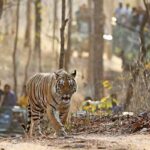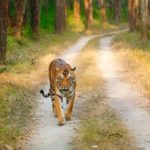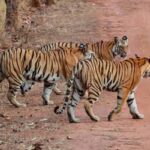Top 10 Jungle Safaris in India The vicious tiger lurks behind dense bamboo bushes, eagerly waiting for its prey. The meditative trance of the sky above is sometimes interrupted by an eagle’s screeching. A herd of deer visits the nearby water hole somewhere in the distance to quench their thirst, even as the sly crocodile stays lifeless, waiting for the right moment to unleash its attack.
These are some of the scenes awaiting you as you embark on a jungle safari through India’s thick forests. This is a safari full of surprises and thrills, unlike any other. To see nature’s inhabitants in their natural environment, revealing raw feelings, is nothing short of a privilege. This blog is for you if you have ever nourished an urge to observe wildlife. Here we’re going to tell you where to go on a jungle safari in India and come across nature’s best sights and sounds.
Did you know that a perfect way to immerse yourself in India’s vibrant culture is to take safaris in India? The vast state has so much beauty, heritage and culture to give to interested tourists that when planning a trip to India, it is difficult to know where to start and end. There is so much exotic diversity everywhere and every corner of the state hides so many special experiences. It seems nearly impossible to catch it all in a short ride. And that’s why the best way to discover the best of India is by taking safaris in India. And to take it up a notch, in India, you can actually take royal safaris. Royal luxury and authentic India are a match made in heaven, so you’ll be sure to have a fun time for years afterwards that you will recall fondly.
Top 10 Jungle Safaris in India, there are several types of royal safaris. The regular car safaris and jeep safaris are available, but the more exotic camel safaris, horse safaris and elephant safaris are also available. A sure-fire way to have an exciting time when zooming along the dunes in a jeep has its own adrenaline-filled pleasures is to travel through the desert on a camel as you stop to visit major sites on your route. Though it’s a fun-filled time on a safari in the morning, the most exotic joy of a safari in India is the camp you set up at night in the desert. When the temperatures fall unexpectedly and the stars show themselves in all their glory, sitting in front of a bonfire is not an experience to have every day. But India’s royal safaris allow you to have them.
On your safari, you will explore the desert of India or lose yourself in the majesty of the wildlife sanctuaries‘ dense forests. You can opt to do a city safari or a heritage safari. By handing over the planning information to your tour operator, you can prepare your own itinerary or let yourself relax. There are many ways to take a safari in India, but you will find yourself enjoying yourself in ways you never thought possible, whichever way you choose Top 10 Jungle Safaris in India.
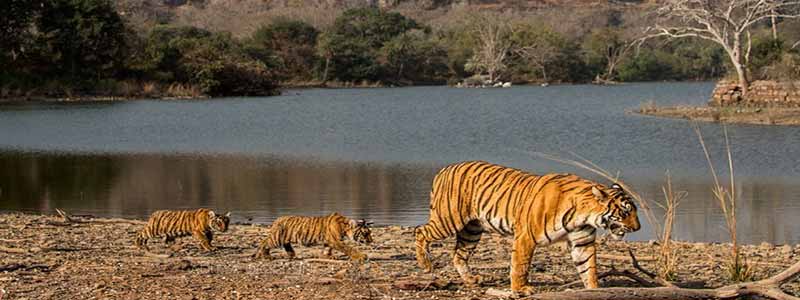
Ranthambore National Park
Ranthambore National Park (Rajasthan) is one of the most popular ecotourism destinations in the entire north and northwest of India with a total area of 1334 sq.km. If we go down to its history, this section was established as the Sawai Madhopur Game Sanctuary by the government of India in 1955. In 1973, it became part of the Tiger Project and obtained the official status of a national park in 1980. Two neighbouring sanctuaries in 1922, i.e. The sanctuaries of Keladevi and Sawai Man Singh were included in it. The park is well-known for the well-planned protection of Bengal tigers and it also makes big cats’ sightings very fast and simple.
Chital, mugger crocodiles, rhesus macaque, southern plains grey langur, sloth bear, striped hyena, sambar, wild boar, nilgai, Indian leopard with various species of reptiles and birds can also be seen in addition to the tigers. It is also home to one of India’s largest banyan trees and is bordered by two distinct rivers: Banas in the north and Chambal in the south. It was home to ‘Machli,’ the wildlife history’s most famous and oldest-living tigress. For multiple species with diverse flora, it continues to be a great breeding ground and the efforts of the officials’ discussion here are also commendable.
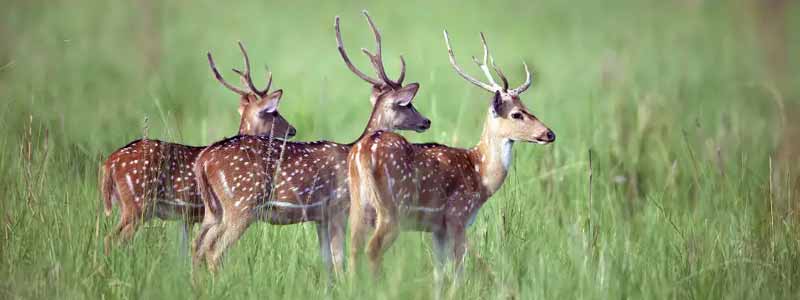
Jim Corbett National Park
Jim Corbett National Park (Uttarakhand) This is the oldest national park in the Uttarakhand district of Nainital and Pauri Garhwal in India. It was called Hailey National Park when it was established in 1936, but it was later rechristened after the renowned hunter and naturalist, Jim Corbett. It was the first park to come under the initiative of Project Tiger and today it is one of the world’s most popular destinations for ecotourism. Host to 488 different kinds of plans, Jim Corbett draws more than 70,000 tourists to the park. When you speak of fauna, it consists of 25 species of reptiles, 580 species of birds, and 50 species of mammals.
This park’s varied geographical features make it more spectacular, with a wide lake, grasslands, marshy depressions, river belts, and hills. The area comprised of the park is 520.8 km2 (201.1 sq mi) and the elevation varies between 1300 and 4000 ft. The park is home to many other species besides the Bengal tiger, including rhesus macaque, langur, Indian pangolins, Himalayan goral, yellow-throated martens, otters, Indian grey mongoose, Himalayan black bears, sloth, chital, hog deer, sambar deer, barking deer, leopards, leopard cat, fishing cat, jungle cat, Indian elephants, crocodiles, gharials, Indian python, and a wide range of birds such as Top 10 Jungle Safaris in India.
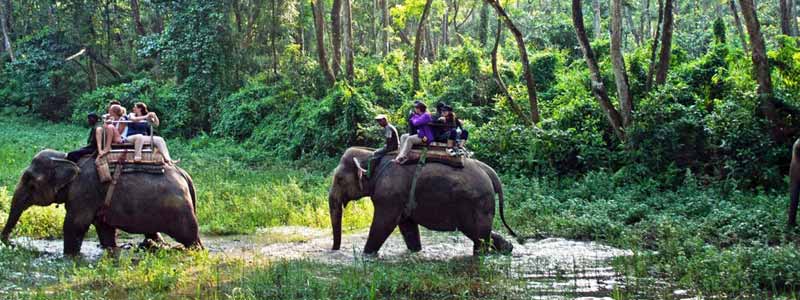
Chitwan National Park
The first national park in Nepal, Chitwan National Park, boasts a beautiful environment and abundant wildlife. Founded in 1973, this park covers an area of 932 km2 (360 m2) and is located in south-central Nepal’s subtropical Inner Terai lowlands. The altitude ranges from 100 m (330 ft) in the valleys of the rivers to 815 m (2,674 ft) higher up in the southern Churia Hills.
Many endangered species are home to Chitwan National Park, such as the larger one-horned rhinoceros, Royal Bengal tiger, gharial crocodile, gangetic freshwater dolphin and others. In addition, there are also four varieties of deer, two types of monkeys, wild boars, sloth bears, elephants and leopards.
For birdwatchers, Chitwan National Park is a paradise. 634 bird species have been reported, including the most endangered Florican Bengal, broad pied hornbill and many reptiles, amphibians and fish.
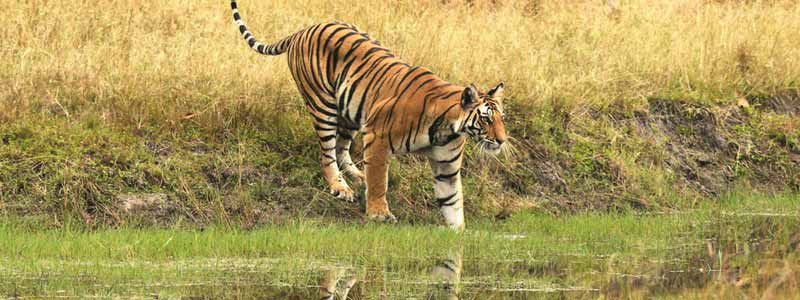
Bandhavgarh National Park
Bandhavgarh National Park (Madhya Pradesh) Bandhavgarh is a national park with an area of 716 km2 situated in Madhya Pradesh’s Umaria district. In 1968, it became officially a national park and was designated a Tiger Reserve in 1993. As per the legend, there is a fascinating fable associated with the name of this park, named after the prominent hillock of the area that became a viewpoint for Lakshmana who was to keep a watch on Lanka by his brother Lord Rama. The park is renowned for its biodiversity and boasts the highest tiger population density in India (8 tigers per square km). Various other species of mammals, birds, reptiles, and butterflies also provide shelter.
Except for tigers, Indian leopard, chital, nilgai, Indian wolf, striped hyena, caracal, nilgai, barking deer, sambar, along with 350 species of birds, are the other animals that you can see in this forest. A large number of sarus cranes and other migratory birds are invited here in the rainy season by the resources and abundance of grasslands. Bandhavgarh lies in the Deccan Peninsula and is part of the deciduous forests (Zone 6A). You can see dense bamboo thickets in the flora between Dhobin, Salai, Saja, and Sal. The Maharaja Martand Singh of Rewa captured a white tiger called Mohan in the year 1951, and its taxidermic statue can still be seen here.
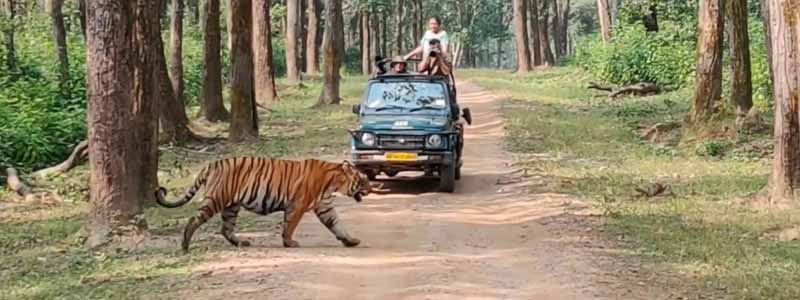
Kanha Tiger Reserve
The Kanha Tiger Reserve is lavishly spread over a large area of 1,949 sq. Km, with an area of 940 sq. Km of core surface area and 1,009 sq. Kilometres of buffer zone; one of the best tiger habitats in India. Munna, the oldest recorded living tiger in the wild, who is a legend in his own right, breaks through these jungles and is identified by a “CAT” sign on his forehead. In these forests, Munna transfers his legacy to his royal son, Chota Munna, who is the dominant male.
In the Central Indian Highlands, which are part of the extensive tableland that forms the main peninsula of India, Kanha is situated. This was once an endless stretch of forests that formed a vital part of the wilderness and wildlife ecosystems of the world. These trees, such as Panna, Bandhavgarh, Kanha, Pench and Sanjay, are now fragmented into parks.
The undulating landscape of Kanha is dotted with thick vegetable groves, hills and meadows. Of all these habitats, its lifeline is Kanha’s meadows, as they maintain large numbers of Chital, Sambar, Barasingha and Gaur, which in turn support predator and co-predator populations such as Tigers, Leopards, Wild Dogs, Jungle Cats and Foxes.
The park, where Bamboo, Tendu, Sal, Jamun, Arjun and Lendia flourish, is primarily a moist Sal and moist mixed deciduous forest. It is home to more than 1,000 flowering plant species and nearly 300 bird species, and is one of the best Top 10 Jungle Safaris in India.
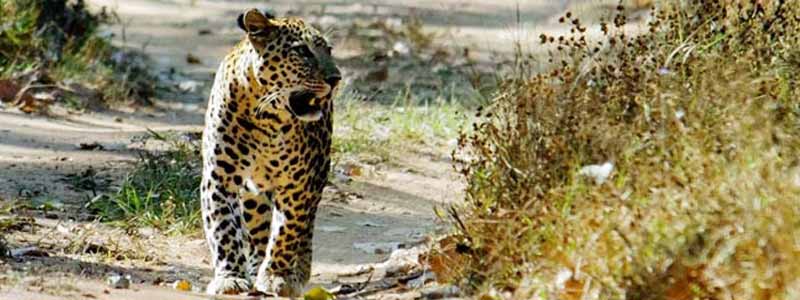
Pench National Park
Nestled in the lower southern reaches of the Satpuda hills, Pench National Park is named after the Pench River, which meanders from north to south through the park. It is situated in the Seoni and Chhindwara districts on the southern frontier of Madhya Pradesh, bordering Maharashtra. 758 SQ Kms of Pench National Park, with a core area of 299 sq km of Indira Priyadarshini Pench National Park The buffer area is the Mowgli Pench Sanctuary and the remaining 464 sq km of Pench National Park.
There is a glorious history of the location of the present tiger reserve. In Ain-i-Akbari, a definition of its natural riches and richness takes place. The original setting of Rudyard Kipling’s most popular novel, The Jungle Book, is The Pench Tiger Reserve and its neighbourhood.

Kaziranga National Park
A World Heritage Site, Kaziranga National Park hosts two-thirds of the world’s great one-horned rhinoceroses and is also home to a high density of tigers. The park is made up of three separate districts and is situated on the edge of the biodiversity hotspot of the Eastern Himalaya. It was declared a Tiger Reserve in 2006 and offers shelter for swamp deer, wild water buffalo, as well as elephants. Kaziranga outdoes all other wildlife reserves when it comes to the maintenance and conservation of protected areas and is also recognised by BirdLife International as an Important Bird Area. With dense tropical broadleaf forests and marshland, herbivores are provided with major sources of sustenance.
It was established as a reserve forest in 1905 and has been the central theme of numerous documentaries, songs, and books. The park only had an area of 232 km2 (90 sq mi) at the time of its creation, and today the official area recognised by the government is 430 km2 (166 sq mi). Floods that take the lives of many animals every year also reach the area. However the resilience of wildlife can be seen clearly as soon as the water recedes. Every year the park manages to draw a great number of visitors and stuns them with its biodiversity. It is made up of numerous bodies of water, swamps, open jungles, short grasses, tall grasses, and a wide range of birds, mammals, reptiles, and insects Top 10 Jungle Safaris in India.
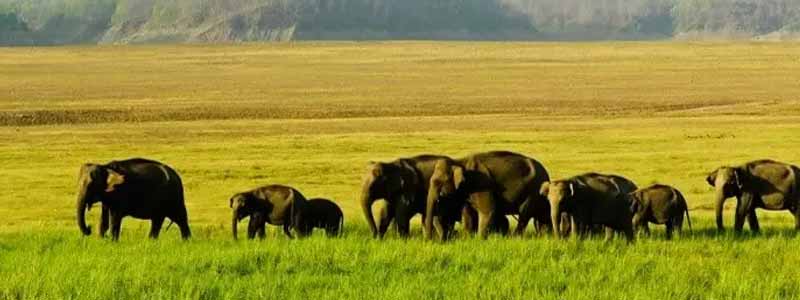
Manas National Park
At the foot of the Himalayas, Manas National Park is located on the bank of the River Mans. The beautiful park formerly known as the wildlife sanctuary of North Kamrup is spread over an area of 519.77 sq km and on December 01, 1928, was declared a sanctuary. It was formed as the centre of the April 1973 Manas Tiger Reserve and on September 7, 1990, it was elevated to the position of National Park status. With its unusual blend of scenic beauty and uncommon abundance of wildlife, it is a well-known World Heritage Site.
In India, Manas is one of the nine tiger reserve sanctuaries. Hispid Hare, Pigmy Hog, Golden Langur, Indian Rhinoceros, Asiatic Buffalo etc. are other wildlife spices found in the national park. Elephant, Leopard, Clouded Leopard, Himalayan Bear, Wild Boar, Samber, Swamp Deer, Hog Deer etc. are some other widely seen species.
Manas is 176 km by road from Guwahati. Lokapriya Gopinath Bordoloi International Airport in Guwahati is the closest airport. Barpeta Road Station, which is 40 km away from Manas, is the nearest railway stop.
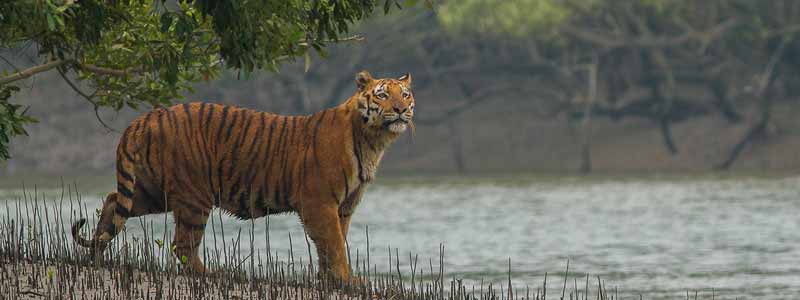
Sundarbans National Park
Sundarbans National Park (West Bengal) Due to its characteristics, this national park has won several names, is a Ramsar site, a UNESCO World Heritage Site, a biosphere reserve, and a tiger reserve. It is one of the largest Bengal tiger reserves in the world and, due to its thick mangrove forests, it also offers a wide spectrum of wildlife. Many species of invertebrates, salt-water crocodiles, birds, and other reptiles are provided with shelter. The history of this park goes back to the 19th century, and under the Forest Act, in 1875, a large part of the mangrove became a reserved forest. It became a refuge for tigers in 1973, a sanctuary for wildlife in 1977, and a national park in 1948.
At present, the total area of the park is 16,900 square kilometres (6,526 sq mi) and Bangladesh is home to a large portion of the delta. Sundarban is also renowned for its marine fauna and avifauna. Some of the bird species you can see here are whistling teals, white-eyed pochards, northern pintails, golden plovers, coils, eastern knots, small stints, black-tailed godwits, Eurasian whimbrels, pariah kites, water hens, storks of openbills, and many others. Few rare species of marine mammals, such as river dolphins of the Ganges, Irrawaddy dolphins, finless porpoises, and many others are also found here.
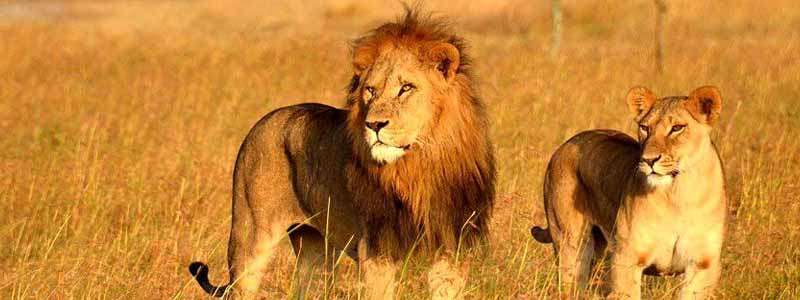
Gir Forest National Park
In the state of Gujarat, Gir National Park is situated along the coast of the far west-central part of India. An region of 545 square miles encompasses the national park area (1,412 sq km). It is referred to as Sasan Gir occasionally.
The national park serves as a sanctuary for wildlife focused on protecting the population of Asian lions, which has been growing in recent years. The park consists of a dry deciduous forest mixed in with teak throughout. Collectively, the park is a hilly, dry scrubland landscape.
With four dams that have produced four reservoirs, there are seven perennial rivers flowing through the park. Some of the best opportunities to record the views of wildlife are these water bodies. Datardi, Godavari, Hiran, Machhundri, Raval, Shetrunji, and Shingoda constitute the seven rivers. The four rivers which have dams are Hiran, Machhundri, Raval, and Shingoda.
While there are only 38 species of mammals, over 2,300 species are included in the collective wildlife. With 300 species of birds and 37 species of reptiles, insects account for the majority. The park’s predators are the Asian lion, the Indian leopard, the jungle cat, the hyena, the desert cat, the honey badger and the mongoose Top 10 Jungle Safaris in India.


